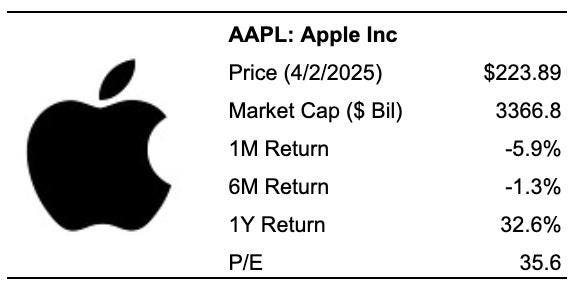Apple stock (NASDAQ:AAPL) fell over 6% in after-hours trading on Wednesday, after President Donald Trump announced a sweeping round of tariffs that would apply to over 100 countries. The iPhone – America’s most iconic gadget – is built almost entirely overseas, exposing Apple to significant cost escalation. The tariffs hit nearly all of Apple’s global production hubs, potentially driving up landed costs for iDevices in the U.S. and squeezing margins. The trade war could also reignite inflation and weigh on the broader U.S. economy and consumer spending. Similarly, see Amazon Stock To $120? How Tariffs Could Reshape Amazon’s Future.
Now, here’s the thing: in a downturn, Apple stock could lose considerably. There is evidence from as recently as 2022 that Apple stock lost over 30% of its value in just a few quarters. So, could Apple’s $223 stock slide to around $150 levels if a repeat of 2022 were to happen? Now, of course, individual stocks are more volatile than a portfolio – and in this environment, if you seek upside with less volatility than a single stock, consider the High-Quality portfolio, which has outperformed the S&P 500 and achieved returns greater than 91% since inception.
Why is that relevant now? Apple has been growing its business steadily via innovative products and a booming services business. There is a larger risk now, given the sweeping tariffs and, the possibility of a widespread trade war with key partners, which puts Apple’s global supply chain at risk.
The latest tariff announcement includes a 34% levy on Chinese imports, a major manufacturing hub for Apple. While Apple has diversified production in recent years, its other key hubs, Vietnam and India, will face 46% and 26% tariffs, respectively. Granted, Apple pledged $500 billion in investments in the U.S. and intends to hire 20,000 workers in the U.S., but these commitments will take several years to materialize. As Trump’s tariffs are imposed on Apple’s products, someone will have to bear the costs. It could be Apple (by reducing its margins), customers (who’d pay more for their iDevices), or even wireless carriers, who might share the burden with Apple via higher device subsidies in order to soften the blow for consumers. Either way, if tariffs go through, Apple’s sales volumes or bottom line could be impacted.
Trump’s bold moves have also stoked fears that inflation could come back. All of this means the U.S. economy could hit a rough spot, and even worse, hit a recession – our analysis here on the macro picture. When you factor in higher geopolitical uncertainty due to bold moves from the new Trump administration, these are critical risks. After all, the Ukraine- Russia war is still ongoing, trade is uncertain. Tariffs drive up import costs and typically result in price hikes, lower disposable income, and weaker consumer spending. This is bad news for Apple, which relies heavily on discretionary spending. Meanwhile, smartphone feature upgrades have become more incremental, and in a shaky economy, people will be more than willing to hold on to their devices for just a bit longer. That could hit Apple even harder.
How Resilient Is AAPL Stock During A Downturn?
To be sure, AAPL stock is viewed as a safe haven and has been more resilient than the benchmark S&P 500 index during some of the recent downturns. However, this time around, the company’s international supply chain and dependence on foreign manufacturing could prove a liability. Worried about the impact of a market crash on AAPL stock? Our dashboard How Low Can Apple Stock Go In A Market Crash? has a detailed analysis of how the stock performed during and after previous market crashes.
Inflation Shock (2022)
- AAPL stock fell 30.8% from a high of $182.01 on 3 January 2022 to $126.04 on 28 December 2022, vs. a peak-to-trough decline of 25.4% for the S&P 500
- The stock fully recovered to its pre-Crisis peak by 12 June 2023
- Since then, the stock has increased to a high of $259.02 on 26 December 2024 and currently trades at around $235
Covid Pandemic (2020)
- AAPL stock fell 30.7% from a high of $80.91 on 19 February 2020 to $56.09 on 23 March 2020, vs. a peak-to-trough decline of 33.9% for the S&P 500
- The stock fully recovered to its pre-crisis peak by 3 June 2020
Global Financial Crisis (2008)
- AAPL stock fell 60.9% from a high of $7.14 on 30 December 2007 to $2.79 on 20 January 2009, vs. a peak-to-trough decline of 56.8% for the S&P 500
- The stock fully recovered to its pre-crisis peak by 21 October 2009
In summary, it also doesn’t help that Apple’s stock is still expensive; it trades at almost 30x consensus FY’25 earnings. To make matters worse, Apple’s Revenues have only grown marginally over recent years. Apple has seen its top line grow at an average rate of 2.3% per year over the last 3 years (vs. 9.8% for the S&P 500).
Given this growth deceleration and the broader economic uncertainties, ask yourself the question: do you want to hold on to your Apple stock now, will you panic and sell if it starts dropping to $200, $150, or even lower levels? Holding on to a falling stock is never easy. Trefis works with Empirical Asset Management — a Boston area wealth manager — whose asset allocation strategies yielded positive returns during the 2008-09 period when the S&P lost more than 40%. Empirical has incorporated the Trefis HQ Portfolio in this asset allocation framework to provide clients better returns with less risk versus the benchmark index; less of a roller-coaster ride, as evident in HQ Portfolio performance metrics.
Invest with Trefis
Market Beating Portfolios | Rules-Based Wealth
Read the full article here


